The Role of Woodlots in Forest Regeneration outside Protected Areas: Lessons from Tanzania
Abstract
1. Introduction
- (1)
- Determine historical trends in tree cover for the area under protection versus under smallholder management;
- (2)
- Identify site conditions and management factors that determine variations in native tree seedling density and richness under the three regeneration strategies (Protect and Wait, Native Tree Planting, and Woodlots); and
- (3)
- Identify factors associated with allocating land to woodlots among smallholder farmers.
2. Methods
2.1. Study Site
2.2. Data Collection
2.3. Data Analysis
3. Results
3.1. Historical Tree Cover Trajectories
3.2. Patterns and Predictors of Native Tree Seedlings Abundance and Richness
3.3. Land-Use Factors Associated with Tree Planting among Smallholder Farmers
4. Discussion
4.1. Use of Historical Land Cover to Establish Regeneration Baselines
4.2. Understanding Distribution Patterns of Native Seedlings
4.3. Strategic Application of Regeneration Strategies
5. Conclusions
Author Contributions
Funding
Acknowledgments
Conflicts of Interest
Appendix A
| Regeneration Stratergy | Location | Corridor Area (Length) | Actions | Land Use | Cost Financial; Social | Reported Success | Reported Challenges | Citations |
|---|---|---|---|---|---|---|---|---|
| Protect and Wait | § Mwanihana Corridor: Udzungwa Mountains-Magombera Forest, Tanzania | 600 Ha | Fenced corridor | sugarcane cultivation (Ilovo plantation + out-grower); smallholder farms | [58] | |||
| Gombe-Masito-Ugalla, Tanzania | 13,000 Ha | land use planning, seedling development, tree planting | Village land to protected | USAID 1-funded | Coordinated land use planning across 49 villages | [29] | ||
| § Mngeta Corridor: (Udzungwa Scarp – Northern Udzungwa forests), Tanzania | 6300 Ha | Improve protection; prevent future settlement | Smallholder land + Public Land | ~90 households | [59] | |||
| Usambara East (Derema), Tanzania | 790 Ha | Land use assessment; Resettlement of farms, prevent future cultivation | Smallholder land to protected | $2.5 million; 1128 farmers affected; relocated 1547 farm parcels (not homes) | [57,60] | |||
| Mount Kenya-Laikipia, Kenya | (14 km) | Fenced underpass from highland to lowland | ~ $1 million (without annual maintenance); | [61] | ||||
| Protect and Wait + Native Tree Planting | Gishwati-Nyungwe, Rwanda | 262 Ha | Resettlement, protection, restoration (with native + non-native species) | Smallholder land to protected | 150 households resettled | [26,62] | ||
| Kibale Forest, Uganda | 10,000 Ha (16 km) | Large-scale restoration of high-canopy forest in grassland. Tree planting and fire suppression. | Smallholder and to protected | 30,000 smallholders evicted 17 years prior | 3600 trees planted, 5000 saplings regenerated | Fire problems. Security issues. Crop loss complaints from local communities. | [24,28] | |
| Gishwati-Nyungwe, Rwanda | 262 Ha | Resettlement, Protection, Restoration (with native + non-native species) | Smallholder land to protected | 150 households resettled | [26,62] | |||
| Native Tree Planting | Nyungwe National Park, Rwanda | 9 Ha | Manual clearing of fern; fire suppression | Inside protected area | USAID-funded; | repeated fern removal for 3 years; regeneration | [50] | |
| § West Mau Forest Reserve Conservation Corridor, Kenya | (1.8 km) | Exotic tree plantations removal | smallholder farms + exotic tree plantations | NA | [63] | |||
| Wambabya and Bugoma Central Forest Reserves, Uganda | 96,732 Ha | Eucalyptus for fuelwood & timber. Native species planting in degraded forest. | Village land | NA | [64] |
| Aerial Photo | Scale | Ground Control Points | Transformation | Mean RMSE 1 |
|---|---|---|---|---|
| SHEET 259 YR.1949 FILM 82A-294 EXP.5017 | 1:44,000 | 10 | Thin Plate Spline | 3.139 × 108 |
| SHEET 259 YR.1949 FILM 82A-294 EXP.5018 | 1:44,000 | 11 | Thin Plate Spline | 1.284 × 107 |
| SHEET 259 YR.1949 FILM 82A-294 EXP.5019 | 1:44,000 | 10 | Thin Plate Spline | 3.216 × 108 |
| SHEET 259 YR.1949 FILM 82D-612 EXP.5004 | 1:22,000 | 10 | Thin Plate Spline | 1.102 × 107 |
| SHEET 259 YR.1949 FILM 82D-612 EXP.5005 | 1:22,000 | 10 | Thin Plate Spline | 1.130 × 104 |
| SHEET 259 YR.1949 FILM 82D-612 EXP.5006 | 1:22,000 | 7 | Thin Plate Spline | 2.066 × 107 |
| SHEET 259 YR.1969 ROLL 13 LINE 2 EXP. 48 | 1:68,000 | 10 | Thin Plate Spline | 4.431 × 108 |
| SHEET 259 YR.1969 ROLL 13 LINE 2 EXP. 49 | 1:68,000 | 10 | Thin Plate Spline | 2.588 × 109 |
| SHEET 259 YR.1969 ROLL 13 LINE 3 EXP. 84 | 1:68,000 | 10 | Thin Plate Spline | 1.311 × 107 |
| SHEET 259 YR.1976 FILM 1829 LINE 73 EXP.24 | 1:50,000 | 12 | Thin Plate Spline | 4.242 × 108 |
| SHEET 259 YR.1976 FILM 1829 LINE 73 EXP.25 | 1:50,000 | 11 | Thin Plate Spline | 1.819 × 106 |
| SHEET 259 YR.1976 FILM 1829 LINE 73 EXP.35 | 1:50,000 | 15 | Thin Plate Spline | 1.660 × 107 |
| SHEET 259 YR.1976 FILM 1829 LINE 73 EXP.36 | 1:50,000 | 11 | Thin Plate Spline | 7.282 × 108 |
| SHEET 259 YR.1985 FILM 3 LINE 4 EXP.6631 | 1:25,000 | 10 | Thin Plate Spline | 1.840 × 107 |
| SHEET 259 YR.1985 FILM 3 LINE 4 EXP.6632 | 1:25,000 | 11 | Thin Plate Spline | 9.097 × 108 |
| SHEET 259 YR.1985 FILM 3 LINE 4 EXP.6633 | 1:25,000 | 11 | Thin Plate Spline | 1.377 × 107 |
| SHEET 259 YR.1985 FILM 3 LINE 5 EXP.6628 | 1:25,000 | 11 | Thin Plate Spline | 3.115 × 107 |
| SHEET 259 YR.1985 FILM 3 LINE 5 EXP.6629 | 1:25,000 | 20 | Thin Plate Spline | 2.688 × 108 |
| Distance from Forest Edge | Southern: Smallholder | Northern: Protected | ||||||||
|---|---|---|---|---|---|---|---|---|---|---|
| Number of Observations | NULL Count | Total No Seedlings | Species Count | Avg Sdln/Obs | Number of Observations | NULL Count | Total No Seedlings | Species Count | Avg Sdln/Obs | |
| 0–50 | 56 | 12 | 133 | 23 | 2.4 | 28 | 19 | 26 | 7 | 0.9 |
| 50–100 | 53 | 20 | 109 | 15 | 2.1 | 27 | 17 | 63 | 8 | 2.3 |
| 100–150 | 46 | 12 | 86 | 15 | 1.9 | 25 | 13 | 32 | 5 | 1.3 |
| 150–200 | 40 | 23 | 39 | 9 | 1.0 | 21 | 11 | 19 | 9 | 0.9 |
| 200–250 | 28 | 13 | 35 | 5 | 1.3 | 7 | 7 | 0 | 0 | 0.0 |
| 250–300 | 22 | 11 | 20 | 2 | 0.9 | 3 | 3 | 0 | 0 | 0.0 |
| 300–350 | 31 | 19 | 17 | 4 | 0.5 | NA | 0 | NA | 0 | NA |
| 350–400 | 15 | 10 | 10 | 7 | 0.7 | NA | 0 | NA | 0 | NA |
| Sum | 290 | 120 | 111 | 70 | ||||||
| Proportion | 0.41 | 0.63 | ||||||||
| Study Site Portion | No. Plots | Plots with NULL obs. | Seedlings Total | Species Count | No. Native Seedlings | Top Three Seedling Species |
|---|---|---|---|---|---|---|
| Overall | 401 | 190 | 589 | 32 | 484 | 1. Morella salicifolia subsp kilimandscharica; 2. Maesa lanceolata; 3. Pinus patula |
| Northern portion | 111 | 70 | 140 | 13 | 140 | 1. Maesa lanceolata; 2. Myrsine melanophloeos; 3. Morella salicifolia subsp kilimandscharica; |
| Southern portion | 290 | 120 | 449 | 28 | 344 | 1. Morella salicifolia subsp kilimandscharica; 2. Pinus patula; 3. Maesa lanceolata |
| Local Name | Scientific Name | # Circles | Seedling Tally | % Total Tally | Early Colonizer | Woodland Species | Slow-Growing Native | Fast-Growing Native | Planted/Exotic |
|---|---|---|---|---|---|---|---|---|---|
| msibisibi | Morella salicifolia subsp kilimandscharica | 103 | 169 | 28.7 | no | yes | yes | no | no |
| mkuti | Maesa lanceolata | 51 | 120 | 20.4 | yes | yes | yes | no | no |
| paina | Pinus patula | 67 | 93 | 15.8 | NA | NA | NA | NA | yes |
| msese | Myrsine melanophloeos | 8 | 32 | 5.4 | no | no | yes | no | no |
| msenye | Agarista salicifolia | 21 | 28 | 4.8 | yes | yes | yes | no | no |
| msya | Bridelia micrantha | 12 | 20 | 3.4 | no | no | yes | no | no |
| mporopotwa | Vernonia myriantha | 6 | 17 | 2.9 | yes | yes | no | yes | no |
| msangabale | Aphloia theiformis | 9 | 13 | 2.2 | no | no | yes | no | no |
| mkolya | Dodonaea viscosa var angustofolia | 6 | 10 | 1.7 | yes | yes | no | yes | no |
| msyunguti | Bersama abyssinica | 7 | 9 | 1.5 | no | no | yes | no | no |
| mtangasale | Albizia gummifera | 4 | 7 | 1.2 | no | yes | yes | no | no |
| mkandana | Parinari excelsa | 1 | 7 | 1.2 | no | no | yes | no | no |
| mpodo | Podocarpus latifolius | 4 | 6 | 1 | no | no | yes | no | no |
| mfwandilo | Ilex mitis | 6 | 6 | 1 | no | no | yes | no | no |
| msongwa dume | Garcinia kingaensis | 5 | 5 | 0.8 | no | no | yes | no | no |
| mkambokambo | Cupressus lusitanica | 4 | 5 | 0.8 | NA | NA | NA | no | yes |
| kipwa | Galiniera saxifraga | 2 | 5 | 0.8 | no | no | yes | no | no |
| mlimbo | Maytenus acuminata | 3 | 4 | 0.7 | no | no | yes | no | no |
| msiiti | Ficalhoa laurifolia | 2 | 3 | 0.5 | no | no | yes | no | no |
| mparachichi | Persea americana | 2 | 4 | 0.7 | NA | NA | NA | NA | yes |
| mlingoti | Eucalyptus maidenii | 3 | 3 | 0.5 | NA | NA | NA | NA | yes |
| Mturuhunga | Hagenia abyssinica | 1 | 2 | 0.3 | no | yes | yes | no | no |
| mswisa | Myrianthus holstii | 2 | 2 | 0.3 | no | no | yes | no | no |
| msuluti | Catha edulis | 2 | 2 | 0.3 | no | no | yes | no | no |
| msengela | Macaranga capensis var kilimandscharica | 2 | 2 | 0.3 | no | no | yes | no | no |
| mpembati | Polyscias fulva | 2 | 2 | 0.3 | no | no | yes | no | no |
| mkuyu | Ficus sur | 2 | 2 | 0.3 | no | no | yes | no | no |
| mtitisieli | Peperomia tetraphylla | 1 | 1 | 0.2 | yes | yes | no | yes | no |
| mbojo | Tecomaria capensis | 1 | 1 | 0.2 | yes | yes | no | yes | no |
| mberigati | Cornus volkensii | 1 | 1 | 0.2 | no | no | yes | no | no |
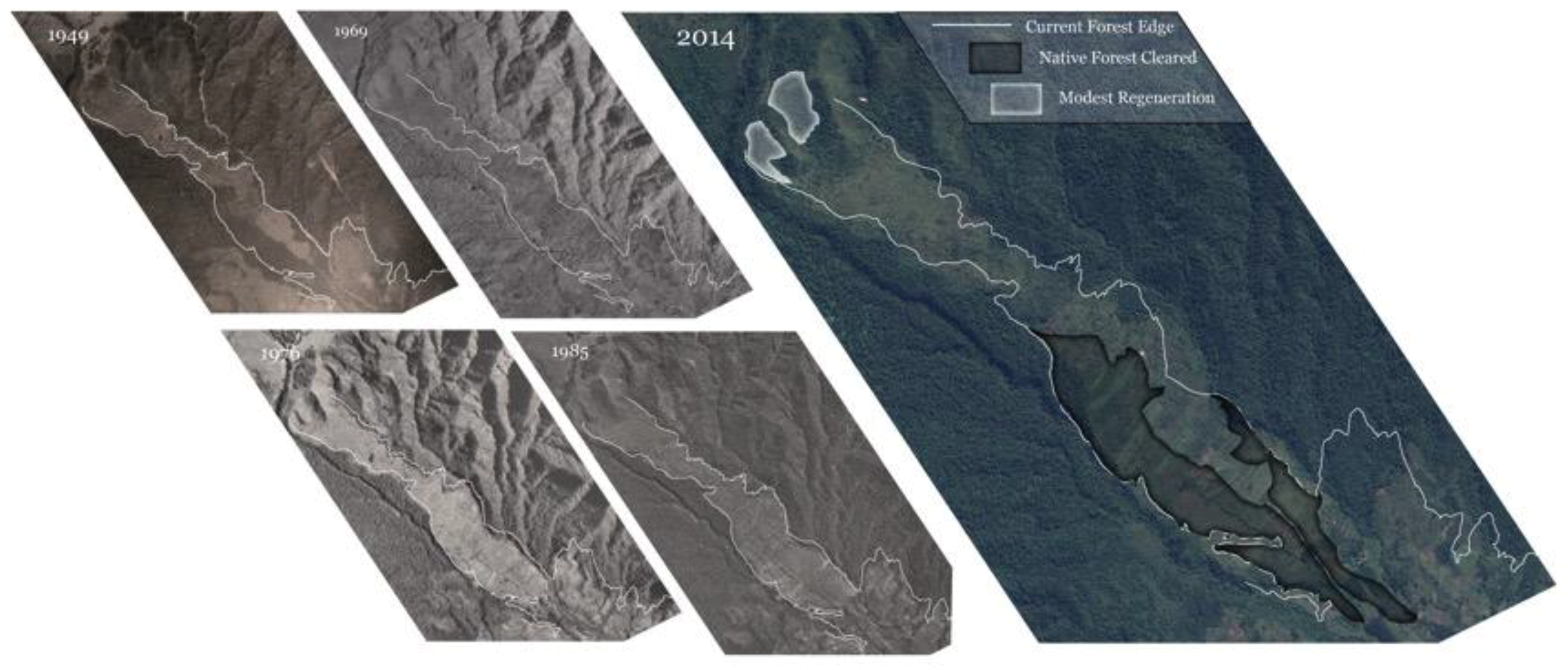
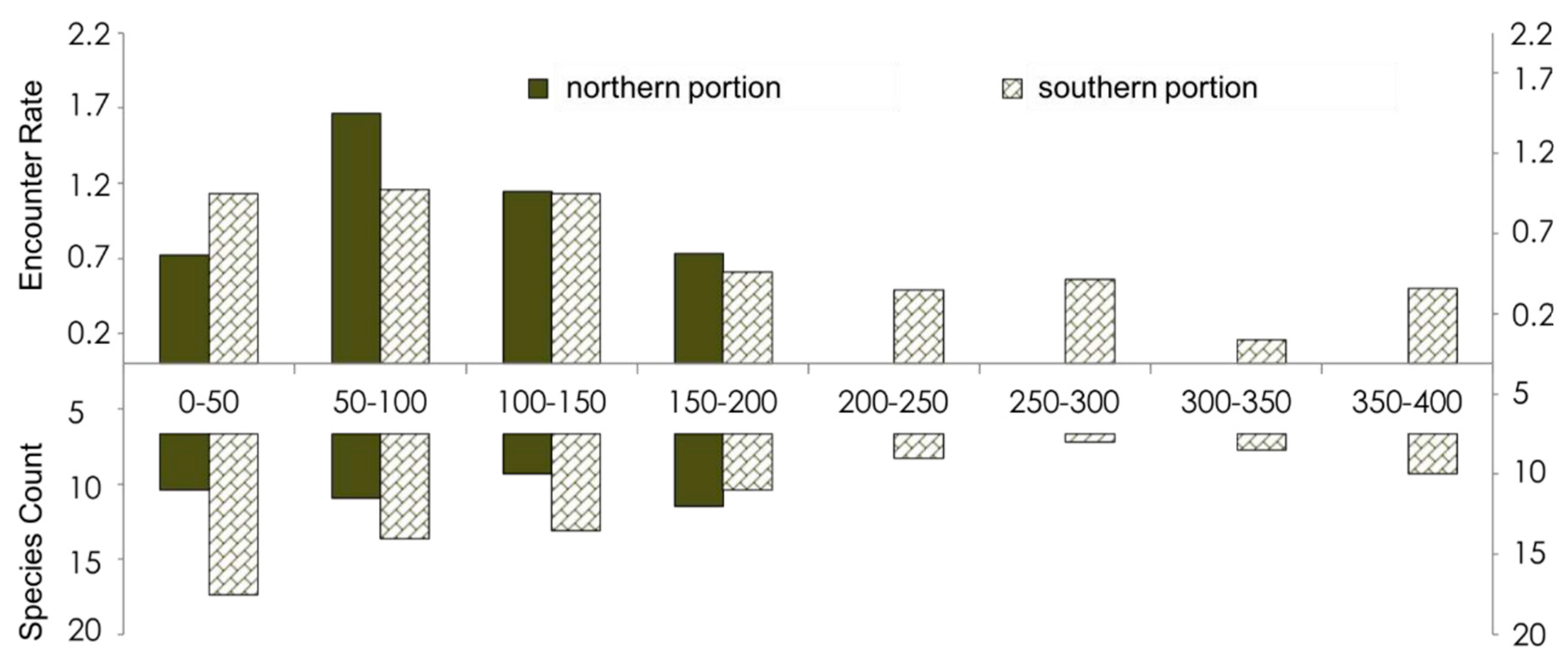
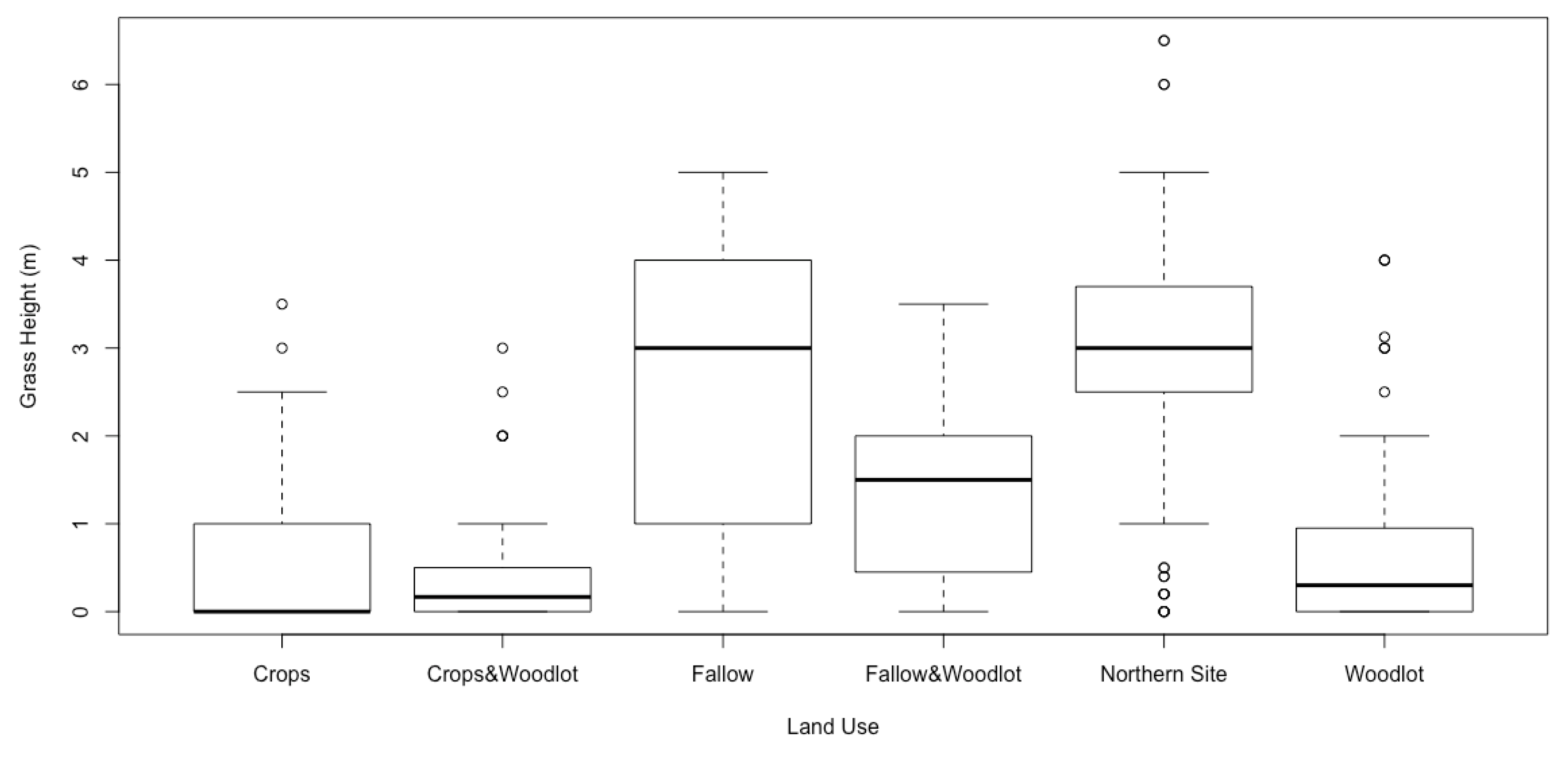
References
- Margules, C.R.; Pressey, R.L. Systematic conservation planning. Nature 2000, 405, 243–253. [Google Scholar] [CrossRef] [PubMed]
- Fischer, J.; Lindenmayer, D.B. Landscape modification and habitat fragmentation: A synthesis. Glob. Ecol. Biogeogr. 2007, 16, 265–280. [Google Scholar] [CrossRef]
- Hilty, J.A.; Lidicker, W.Z., Jr.; Merenlender, A.M. Corridor Ecology: The Science and Practice of Linking Landscapes for Biodiversity Conservation; Island Press: Washington, DC, USA, 2006. [Google Scholar]
- Cincotta, R.P.; Wisnewski, J.; Engelman, R. Human population in the biodiversity hotspots. Nature 2000, 404, 990–992. [Google Scholar] [CrossRef] [PubMed]
- IUCN. UNEP-WCMC The World Database on Protected Areas (WDPA). Available online: www.protectedplanet.net (accessed on 1 November 2016).
- Newmark, W.D.; Mcneally, P.B. Impact of habitat fragmentation on the spatial structure of the Eastern Arc forests in East Africa: Implications for biodiversity conservation. Biodivers. Conserv. 2018, 27, 1387–1402. [Google Scholar] [CrossRef]
- Cordeiro, N.J.; Burgess, N.D.; Dovie, D.B.K.; Kaplin, B.A.; Plumptre, A.J.; Marrs, R. Conservation in areas of high population density in sub-Saharan Africa. Biol. Conserv. 2007, 134, 155–163. [Google Scholar] [CrossRef]
- Burgess, N.; Butynski, T.; Cordeiro, N.; Doggart, N.; Fjeldsa, J.; Howell, K.; Kilahama, F.; Loader, S.; Lovett, J.; Mbilinyi, B. The biological importance of the Eastern Arc Mountains of Tanzania and Kenya. Biol. Conserv. 2007, 134, 209–231. [Google Scholar] [CrossRef]
- National Bureau of Statistics. 2012 Population and Housing Census; Population Distribution by Adminstrative Areas; National Bureau of Statistics: Dar-es-Salaam, Tanzania, 2013.
- Ayebare, S.; Ponce-Reyes, R.; Segan, D.B.; Watson, J.E.M.; Possingham, H.P.; Seimon, A.; Plumptre, A.J. Identifying Climate-Resilient Corridors for Conservation in the Albertine Rift; Unpublished Report; The Wildlife Conservation Society to MacArthur Foundation: New York, NY, USA, 2013. [Google Scholar]
- Moilanen, A.; Wilson, K.; Possingham, H.P. (Eds.) Spatial Conservation Prioritization: Quantitative Methods and Computational Tools; Oxford Universiy Press: Oxford, UK, 2009. [Google Scholar]
- Wiens, J.A.; Safford, H.D.; McGarigal, K.; Romme, W.H.; Manning, M. What is the Scope of “History” in Historical Ecology? Issues of Scale in Management and Conservation. Hist. Environ. Var. Conserv. Nat. Resour. Manag. 2012, 63–75. [Google Scholar] [CrossRef]
- Chapman, C.A.; Chapman, L.J. Mid-Elevation Forests: A history of disturbance and Regeneration. In East African Ecosystems and Their Conservation; McClanahan, T.R., Young, T.P., Eds.; Oxford Universiy Press: Oxford, UK, 1996; pp. 385–400. [Google Scholar]
- Newmark, A.W.D. Forest area, fragmentation, and loss in the Eastern Arc Mountains: Implications for the conservation of biological diversity. J. East Afr. Nat. Hist. 1998, 87, 29–36. [Google Scholar] [CrossRef]
- Jackson, S.T.; Stephen, T. Vegetation, environment, and time: The origination and termination of ecosystems. J. Veg. Sci. 2006, 17, 549–557. [Google Scholar] [CrossRef]
- Holl, K.D.; Aide, T.M. When and where to actively restore ecosystems? For. Ecol. Manag. 2011, 261, 1558–1563. [Google Scholar] [CrossRef]
- Holl, K.D. Factors Limiting Tropical Rain Forest Regeneration in Abandoned Pasture: Seed Rain, Seed Germination Microclimate and Soil. Biotropica 1999, 31, 229–242. [Google Scholar] [CrossRef]
- De Souza, F.M.; Batista, J.L.F. Restoration of seasonal semideciduous forests in Brazil: Influence of age and restoration design on forest structure. For. Ecol. Manag. 2004, 191, 185–200. [Google Scholar] [CrossRef]
- Chapman, C.A.; Chapman, L.J. Forest restoration in abandoned agricultural land: A case study from East Africa. Conserv. Biol. 1999, 13, 1301–1311. [Google Scholar] [CrossRef]
- Chapman, C.A.; Chapman, L.J.; Kaufman, L.; Zanne, A.E. Potential causes of arrested succession in Kibale National Park: Growth and mortality of seedlings. Afr. J. Ecol. 1999, 37, 81–92. [Google Scholar] [CrossRef]
- Holl, K.D. Effect of shrubs on tree seedling establishment in an abandoned tropical pasture. J. Ecol. 2002, 90, 179–187. [Google Scholar] [CrossRef]
- Omeja, P.A.; Lwanga, J.S.; Obua, J.; Chapman, C.A. Fire control as a simple means of promoting tropical forest restoration. Trop. Conserv. Sci. 2011, 4, 287–299. [Google Scholar] [CrossRef]
- Piiroinen, T.; Valtonen, A.; Roininen, H. Exotic plantations can ignite forest succession in the Afrotropis where natural forest regeneration is slow. Afr. J. Ecol. 2016, 54, 478–484. [Google Scholar] [CrossRef]
- Feeney, P. Accountable Aid: Local Participation in Major Projects; Oxfoam Publications: Oxford, UK, 1998. [Google Scholar]
- Pusey, A.E.; Pintea, L.; Wilson, M.L.; Kamenya, S.; Goodall, J. The contribution of long-term research at Gombe National Park to chimpanzee conservation. Conserv. Biol. 2007, 21, 623–634. [Google Scholar] [CrossRef]
- Saad, M.; Regan, J.; Chen, J.; Muzungu, E.; Mwiza, F.; Paulson, C.; Weiser, J.; Willis, A. Highway for Apes: Using NASA EOS for Wildlife Corridor Planning in Rwanda. Available online: https://earthzine.org/2013/04/03/highway-for-apes-using-nasa-eos-for-wildlife-corridor-planning-in-rwanda/ (accessed on 1 January 2017).
- Lwanga, J.S. Forest succession in Kibale National Park, Uganda: Implications for forest restoration and management. Afr. J. Ecol. 2003, 41, 9–22. [Google Scholar] [CrossRef]
- UWA. FACE Natural High Forest Rehabilitation Project on Degraded Land of Kibale; UWA: Kampala, Uganda, 2011. [Google Scholar]
- Cerf, C. Jane Goodall’s Win-Win. Available online: https://www.usaid.gov/news-information/frontlines/depleting-resources/jane-goodalls-win-win (accessed on 1 January 2017).
- WCS REDD. Readiness in Southwest Tanzania The Development of Standardized Approaches for Establishing Baseline Information Monitoring Forest Degradation and Supporting Community Incentives Education and Resource Supply in Support of Redd in Tanzania with; WCS REDD: Mbeya, Tanzania, 2014. [Google Scholar]
- Ngaga, Y.M. Forest Plantations and Woodlots in Tanzania. Afr. For. Forum 2011, 16, 1–80. [Google Scholar]
- Pistorius, T.; Carodenuto, S.; Wathum, G. Implementing Forest Landscape Restoration in Ethiopia. Forests 2017, 8, 61. [Google Scholar] [CrossRef]
- Watkins, C.A. Natural resource use strategies in a forest-adjacent Ugandan village. Hum. Ecol. 2009, 37, 723–731. [Google Scholar] [CrossRef]
- Koskinen, J.; Leinonen, U.; Vollrath, A.; Ortmann, A.; Lindquist, E.; D’annunzio, R.; Pekkarinen, A.; Käyhkö, N. Participatory mapping of forest plantations with Open Foris and Google Earth Engine. ISPRS J. Photogramm. Remote Sens. 2019, 148, 63–74. [Google Scholar] [CrossRef]
- L’Roe, J.; Naughton-Treves, L. Forest edges in western Uganda: From refuge for the poor to zone of investment. For. Policy Econ. 2017, 84, 102–111. [Google Scholar] [CrossRef]
- Chapman, C.; Chapman, L. Exotic tree plantations and the regeneration of natural forests in Kibale National Park, Uganda. Biol. Conserv. 1996, 76, 253–257. [Google Scholar] [CrossRef]
- Chhetri, P.B.; Barrow, E.G.C.; Muhweezi, A. Securing Protected Area Integrity and Rural People’s Livelihoods: Lessons from Twelve Years of the Kibale and Semliki Conservation and Development Project; IUCN: Gland, Switzerland, 2004; ISBN 2831707811. [Google Scholar]
- Etongo, D.; Djenontin, I.N.S.; Kanninen, M.; Fobissie, K. Smallholders’ tree planting activity in the ziro province, southern burkina faso: Impacts on livelihood and policy implications. Forests 2015, 6, 2655–2677. [Google Scholar] [CrossRef]
- Jenbere, D.; Lemenih, M.; Kassa, H. Expansion of Eucalypt Farm Forestry and Its Determinants in Arsi Negelle District, South Central Ethiopia. Small Scale For. 2012, 11, 389–405. [Google Scholar] [CrossRef]
- Telila, H.; Hylander, K.; Nemomissa, S. The potential of small Eucalyptus plantations in farmscapes to foster native woody plant diversity: Local and landscape constraints. Restor. Ecol. 2015, 23, 918–926. [Google Scholar] [CrossRef]
- Salter, R.F.; Davenport, T.R.B. Orchids and Wildflowers of the Kitulo Plateau; WILDGuides: Old Basing, Hampshire, UK, 2011. [Google Scholar]
- WCS. The Tanzania–Norway Partnership on REDD Climate Change: REDD Readiness in Southwest Tanzania; WCS: Mbeya, Tanzania, 2013. [Google Scholar]
- Bracebridge, C.E.; Davenport, T.R.B.; Marsden, S.J. Can we extend the area of occupancy of the kipunji, a critically endangered African primate? Anim. Conserv. 2011, 14, 687–696. [Google Scholar] [CrossRef]
- Grosh, M.; Glewwe, P. Designing Household Survey Questionnaires for Developing Countries: Lessons from 15 Years of the Living Standards Measurement Study; Volume 1, 2 and 3; The World Bank: Washington, DC, USA, 2000. [Google Scholar]
- Zeileis, A.; Kleiber, C.; Jackman, S. Regression Models for Count Data in R. J. Stat. Softw. 2008, 27, 1–25. [Google Scholar] [CrossRef]
- Ridout, M.; Demetrio, C.G.; Hinde, J. Models for count data with many zeros. Int. Biom. Conf. 1998, 19, 179–192. [Google Scholar]
- Omoro, L.M.A.; Pellikka, P.K.E.; Rogers, P.C. Tree Species Diversity, Richness, and Similarity between Exotic and Indigenous Forests in the Cloud Forests of Eastern Arc Mountains, Taita Hills, Kenya. J. For. Res. 2010, 21, 255–264. [Google Scholar] [CrossRef]
- Mills, A.J.; Van der Vyver, M.; Gordon, I.J.; Patwardhan, A.; Marais, C.; Blignaut, J.; Sigwela, A.; Kgope, B. Prescribing innovation within a large-scale restoration programme in degraded subtropical thicket in South Africa. Forests 2015, 6, 4328–4348. [Google Scholar] [CrossRef]
- Mugwedi, L.; Rouget, M.; Egoh, B.; Sershen; Ramdhani, S.; Slotow, R.; Renteria, J. An Assessment of a Community-Based, Forest Restoration Programme in Durban (eThekwini), South Africa. Forests 2017, 8, 255. [Google Scholar] [CrossRef]
- WCS. Regenerating Rwanda’s Nyungwe Forest. Available online: https://www.usaid.gov/results-data/success-stories/regenerated-future-nyungwe-forest (accessed on 1 January 2017).
- Mutai, W. Face The Future: Payment for Ecosystem Services Training; Face The Future: Wageningen, The Netherlands, 2011; pp. 1–12. [Google Scholar]
- Lindenmayer, D.B.; Hobbs, R.J. Fauna conservation in Australian plantation forests—A review. Biol. Conserv. 2004, 119, 151–168. [Google Scholar] [CrossRef]
- Barlow, J.; Gardner, T.A.; Araujo, I.S.; Ávila-Pires, T.C.; Bonaldo, A.B.; Costa, J.E.; Esposito, M.C.; Ferreira, L.V.; Hawes, J.; Hernandez, M.I.M.; et al. Quantifying the biodiversity value of tropical primary, secondary, and plantation forests. Proc. Natl. Acad. Sci. USA 2007, 104, 18555–18560. [Google Scholar] [CrossRef]
- Lamb, D. Large-scale Ecological Restoration of Degraded Tropical Forest Lands: The Potential Role of Timber Plantations. Restor. Ecol. 1998, 6, 271–279. [Google Scholar] [CrossRef]
- Martino, R.M. Matrix and Edge Effects on the Maintenance of Ecological Function in an Afromontane Protected Area; Antioch University: Keene, NH, USA, 2015. [Google Scholar]
- Miller, D.C.; Muñoz-Mora, J.C.; Christiaensen, L. Prevalence, economic contribution, and determinants of trees on farms across Sub-Saharan Africa. For. Policy Econ. 2017, 84, 47–61. [Google Scholar] [CrossRef]
- Jones, T.; Caro, T.; Davenport, T.R.B. Wildlife Corridors in Tanzania; Tanzania Wildlife Research Institute: Arusha, Tanzania, 2009. [Google Scholar]
- Jones, T.; Bamford, A.J.; Ferrol-Schulte, D.; Hieronimo, P.; Mcwilliam, N.; Rovero, F. Vanishing wildlife corridors and options for restoration: A case study from Tanzania. Trop. Conserv. Sci. 2012, 5, 463–474. [Google Scholar] [CrossRef]
- Rovero, F.; Jones, T. Wildlife Corridors in the Udzungwa Mountains of Tanzania. Ecol. Restor. 2011, 30, 322–331. [Google Scholar] [CrossRef]
- Department of Forestry and Beekeeping (Tanzania) East Usambara Mountains. Resettlement Action Plan for Farm Plots Displaced for Biodiversity Conservation in the Derema Forest Corridor; Department of Forestry and Beekeeping (Tanzania) East Usambara Mountains: Dar es Salaam, Tanzania, 2006. [Google Scholar]
- Nyaligu, M.; Weeks, S. An Elephant Corridor in a Fragmented Conservation Landscape: Preventing the Isolation of Mount Kenya National Park and National Reserve. Parks 2013, 19, 91–102. [Google Scholar] [CrossRef]
- Great Ape Trust. Rwanda’s Forest of Hope to Expand by 21%, begin Corridor for Endangered Chimpanzees; Great Ape Trust: Des Moines, IA, USA, 2010; Available online: https://phys.org/news/2010-02-rwanda-forest-percent-corridor-endangered.html (accessed on 1 January 2017).
- Butynski, T.M.; De Jong, Y.A. South Western Mau Forest Reserve Game-Proof Barrier Feasibility Study. Available online: https://www.idhsustainabletrade.com/publication/south-western-mau-forest-reserve-game-proof-barrier-feasibility-study/ (accessed on 1 January 2017).
- Manumbu, E.; Mosha, M.; Masolwa, P. Integrated General Land Management Planning Meeting Report Pdf; The Nature Conservancy, The Jane Goodal Institute, The Frankfurt Zoological Society: Mpanda, Tanzania, 2012. [Google Scholar]
- Mpunga, N.E.; Machaga, S.J.; Kimiti, S. (Agritechnica, Hanover, Germany). List of seedlings species encountered at Bujingijila Gap and their ecological significance. Personal Communication, 2016. [Google Scholar]

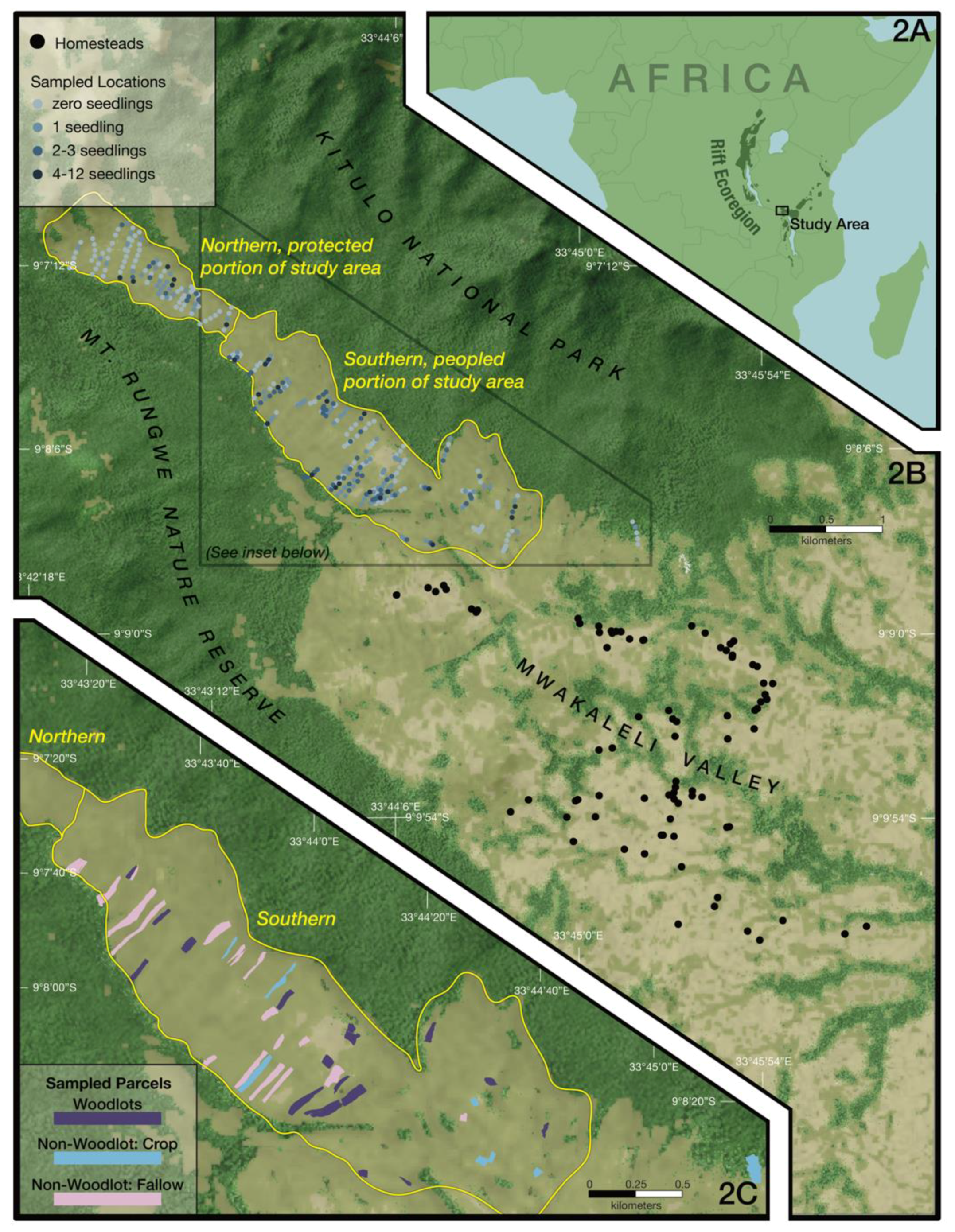
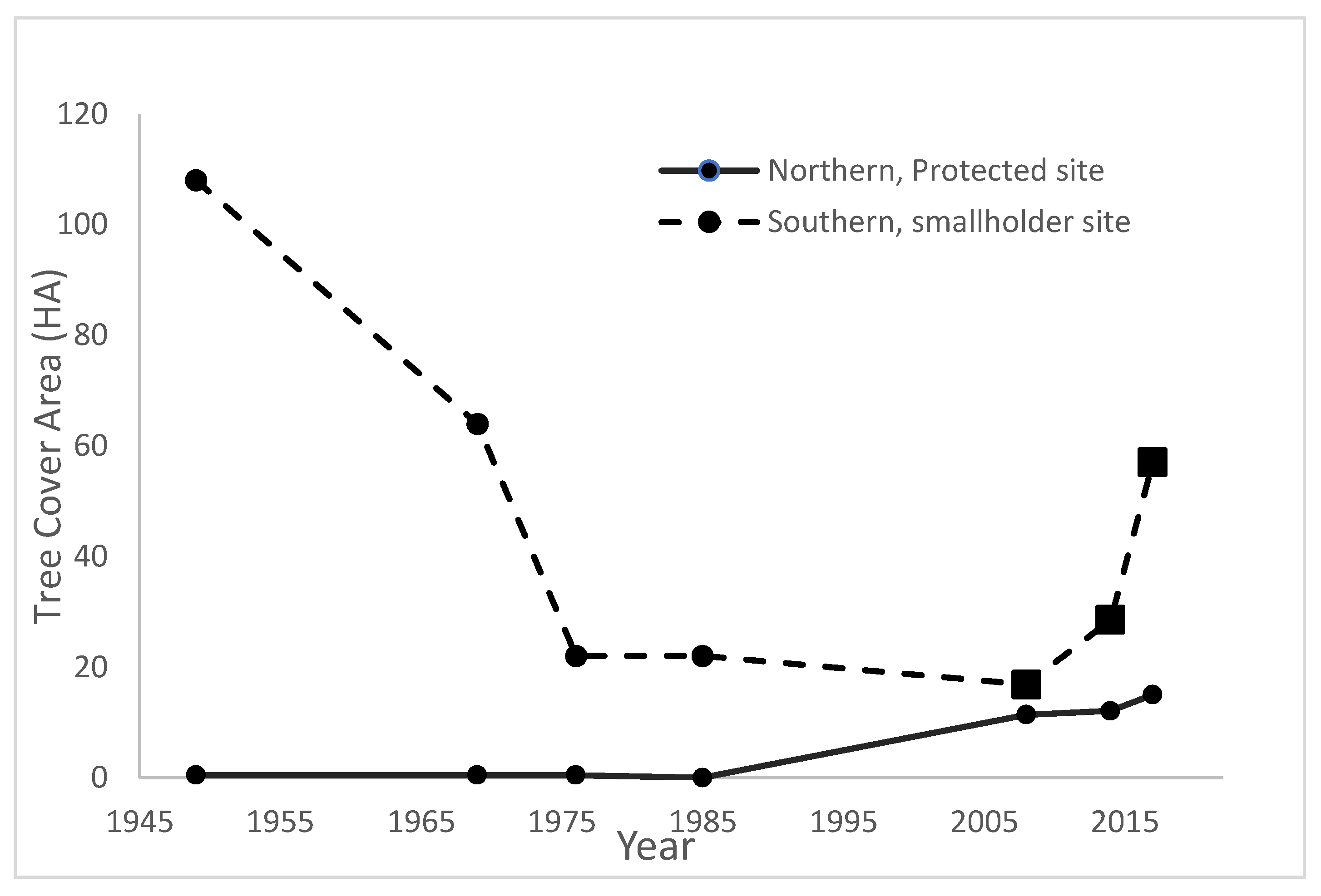
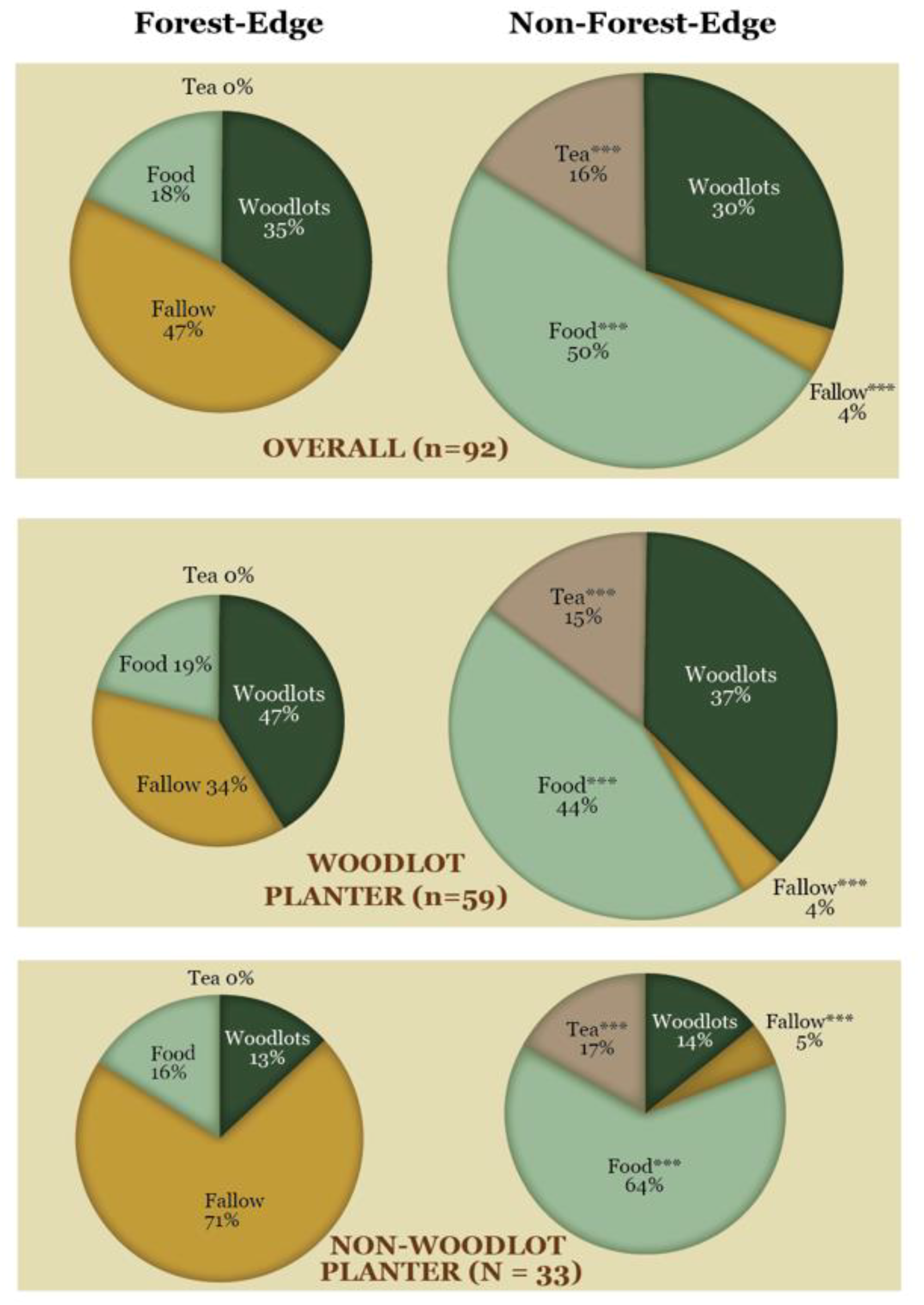
| Metric | Predictors | Entire Site | Protect and Wait | Smallholder All | Woodlots | ||||
|---|---|---|---|---|---|---|---|---|---|
| Count Model | Zero Model | Count Model | Zero Model | Count Model | Zero Model | Count Model | Zero Model | ||
| Seedling abundance | Distance to Forest Edge (m) | 0.99 *** | 1.00 ** | 0.99 *** | 0.99 | 0.99 ** | 1.01 ** | 0.99 ** | 1.00 * |
| Near a Remnant Tree (Y/N) | 1.55 *** | 1.01 | 2.01 *** | 0.52 | 1.40 ** | 1.41 | 1.31+ | 2.56 | |
| Grass Height (m) | 0.99 | 1.44 *** | 0.92 | 1.22 | 0.92 | 1.37 ** | 0.96 | 1.85 * | |
| Log-Likelihood (DF) | −571(8) | −181.4(8) | −373(8) | −240(8) | |||||
| Seedling richness | Distance to Forest Edge (m) | 0.99 *** | 0.99 | 0.99 ** | 0.97 * | 0.99 *** | 1.00 | 0.99 ** | 1.92 |
| Near a Remnant Tree (Y/N) | 1.54 * | 1.73 | 1.83+ | 0.63 | 1.53 * | 15.6 | 1.42+ | 2.86E+43 | |
| Grass Height (m) | 0.93 | 1.77 * | 0.82+ | 1.08 | 0.98 | 3.3 * | 1.07 | 1.03E+25 | |
| Log-Likelihood (DF) | −370(8) | −109(8) | −248(8) | −140(8) | |||||
© 2019 by the authors. Licensee MDPI, Basel, Switzerland. This article is an open access article distributed under the terms and conditions of the Creative Commons Attribution (CC BY) license (http://creativecommons.org/licenses/by/4.0/).
Share and Cite
Kimambo, N.E.; Naughton-Treves, L. The Role of Woodlots in Forest Regeneration outside Protected Areas: Lessons from Tanzania. Forests 2019, 10, 621. https://doi.org/10.3390/f10080621
Kimambo NE, Naughton-Treves L. The Role of Woodlots in Forest Regeneration outside Protected Areas: Lessons from Tanzania. Forests. 2019; 10(8):621. https://doi.org/10.3390/f10080621
Chicago/Turabian StyleKimambo, Niwaeli E., and Lisa Naughton-Treves. 2019. "The Role of Woodlots in Forest Regeneration outside Protected Areas: Lessons from Tanzania" Forests 10, no. 8: 621. https://doi.org/10.3390/f10080621
APA StyleKimambo, N. E., & Naughton-Treves, L. (2019). The Role of Woodlots in Forest Regeneration outside Protected Areas: Lessons from Tanzania. Forests, 10(8), 621. https://doi.org/10.3390/f10080621





